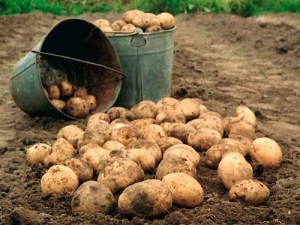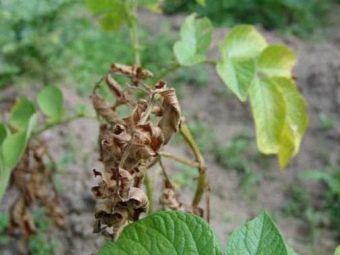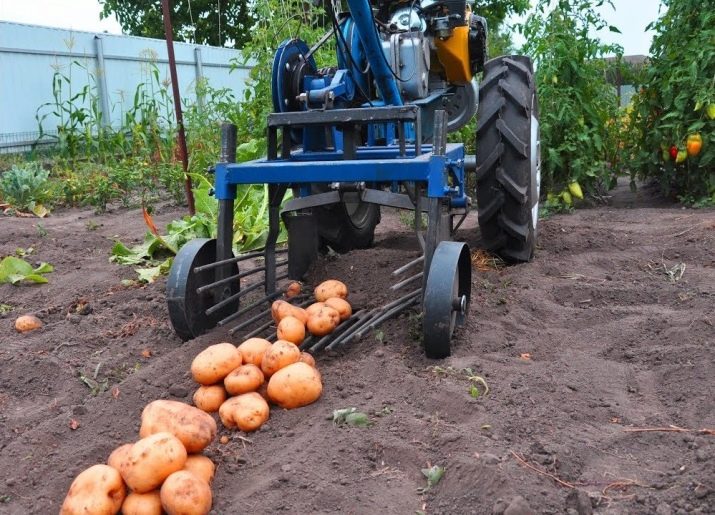When to dig and how to store potatoes?

Learning to grow and harvest potatoes has long been an integral part of the Russian mentality. And it would seem that nothing is simpler, but everything has its own nuances.Beginners in this business risk making a number of mistakes that will entail a lot of unpleasant consequences. And in order to avoid this, it is worthwhile to consider in more detail how and when to dig up ripe potatoes, as well as to share tips on proper and safe storage.
Terms of cleaning
If we are talking about central Russia, then, as a rule, potato harvest takes place in late August or in the first days of autumn. However, when choosing the most appropriate moment, it is necessary to take into account such factors as:
- variety of planted potatoes;
- the timing of his landing;
- weather during the season;
- soil condition;
- degree of exposure to diseases and pests.
And also should take into account many other nuances. The main thing is to know the main features of the variety that is selected for planting. The ripening period is early, middle or late. Sometimes the difference between them is tens of days. Potatoes can ripen by mid-summer.
Experienced gardeners are not advised to dig it all. New potatoes are great for immediate cooking, but because of the thin skin they are not able to be stored for a long time. To check whether the crop is ready for harvesting, it is worth digging one extreme bush, which will become a good example. If the roots have a thick peel and are easily separated from the tops - this means that the time has come. And also there is a way to determine the timing of the appearance of potato bushes. In this case, the culture itself will tell you that it is time to collect. If the tops turned yellow and fell - this means that it is time to dig.
But it may happen that part of the bushes are dead, and the other part is still standing, having a healthy green appearance. Most likely, during planting, varieties with different terms of ripening were mixed. In this case, you need to dig ripe potatoes and let the rest of the bushes ripen. Late varieties are usually harvested in September. With this case, you should not pull, otherwise fall rains. Excess moisture can significantly reduce the storage time of potatoes. For digging, it is worth choosing dry sunny days, which will not only facilitate the work, but also allow the roots to dry faster in the sun.
Harvesting
If it's time to dig the potatoes, go to the preparation. Many ask the question, mow or leave the tops before digging. There is no one right decision. Both options have their pros and cons. The presence of dry bushes will complicate the assembly process. But if you completely remove them, you can simply not find the specific places where they grew up.
In addition, because of inattention, there is a risk of overlooking the bushes infected with blight and spreading the disease throughout the site. Before digging, the entire tops should be inspected for this infection. Affected bushes must be removed entirely with root vegetables. A healthy topper is simply mowed, but not at the root, but so that it can be determined where the potatoes lie. When mowing, you must comply with certain terms, because you should not do this just before digging.
After removing the tops, the potatoes should ripen within one week. If the bushes had to be disposed of immediately due to late blight infection, root crops are given about three weeks for full maturity. Before you start collecting, you need to determine the amount of necessary equipment (boxes, bags and buckets) so that you do not have to throw part of the crop on the ground. Most gardeners already know the approximate volumes collected from their site.
For beginners, there is the following mathematical way to count all the potatoes:
- you need to dig five tubers;
- summarize the number of all fruits received;
- divide this number by five, it turns out the average yield from the bush;
- multiply this value by the number of bushes in the area.
Important! The result is not entirely accurate, but very close. This is enough to prepare the right amount of inventory.
It is necessary to think in advance, than to dig.
- The most obvious and traditional option is a shovel. She will never let you down. Although you need to have on hand a few spare tools in case the stalk breaks. It is necessary to be careful not to poke the ground with a shovel at random. She can cut or completely chop the roots.
- The second option is forks. The process of digging with a pitchfork is not very different from digging with a shovel. However, some gardeners consider this option more simple, since the curved shape of the teeth makes it easier to uproot the tubers from the ground. But the teeth can easily pierce the potatoes. It is better to use forks with fewer teeth. Completely avoid damage to root crops will not succeed. Those potatoes that are cut slightly, can be prepared for food in the near future. And from the critically damaged crop will have to immediately get rid of.
- And the last option is a walk-behind tractor. It is considered the simplest, but only if it has skills in its management. In addition, it is necessary to fork out not only for equipment, but also for additional body kits designed for digging. Motoblock well suited for harvesting large areas. But before this, dry tops should be removed entirely, so that it does not interfere, making it difficult to move the machine. The cultivator is able to select all the tubers from the ground in a short time without damaging them.
When the main work is done and the harvest is gathered, the potatoes need to be dried. Before that, it is worth sorting - to divide the crop by size or by purpose. There are the following options:
- for long-term storage;
- for use soon;
- for livestock feed;
- on planting material for the next spring.
If the harvest is large, and there is not very much free space, it can be dried in batches. Drying takes 4 to 6 hours. For these purposes, perfect sunny day and a little wind. However, potatoes should not be illuminated by sunlight from all sides, otherwise poisonous solanine will accumulate in the pulp. It should cover the crop canopy on the south side.
Storage technology
The first step is to select suitable containers in which potatoes can be stored for a long time. The main thing is that they are well ventilated. To do this, suitable boxes of wood or cardboard, plastic mesh containers, ordinary bags, mesh bags. Potatoes will be stored better in small groups, so you should use a lot of small tars instead of one huge one. The best option are wooden boxes. They are suitable as a container for storing potatoes, because they have a number of advantages.
- Cheap. They can be made independently from unnecessary pieces of wood, for example, from boards, planks, sheets of hardboard or chipboard.
- The gaps between the slats allow the potatoes to get enough oxygen. Through them, you can inspect the stored crop for rot.
- Wooden boxes are light and compact. You can put them on each other, thereby saving space, while the boxes are quite reliable.
In second place are the bags. An important role is played by the material from which they are made. The most suitable solution is the net, because the potato will be able to breathe through it, it will not sweat. And also fit the usual burlap. Due to inexperience, some gardeners use bags of dense polypropylene for storage - this is a gross mistake. This material almost does not allow oxygen, due to the lack of which the potato suffers. Such bags are suitable only for temporary storage or transportation of the crop.
If the winters are cold, it is worth buying a thermal bag But it is worth paying attention that they are expensive. But with them you will not have to worry that the potato will suffer from severe frosts.
Double-layer bags consist of a tent fabric and padding polyester. In addition, they are equipped with electric heating, which keeps the temperature in the range from +1 to + 7ºС.
Closes the top three most demanded plastic containers. They have all the same advantages as wood, except for the fact that they cannot be made at home, so you have to buy. In stores there are special thermal containers equipped with thermal sensors. They automatically regulate the temperature inside and do not allow it to drop below +1 degree. The main disadvantage, again, is the high price.
Everyone can choose the option in which it is better to store potatoes. But where to store it, usually do not have to choose. Therefore it is necessary to consider the main features of different options.
- If there is only an apartment, then storage space is very limited. So, and the large harvest will have to forget. Most Russian residents adapt their goals for this purpose. balconies.
- In rare cases, apartments are available. pantrywhere you can leave a small amount of potatoes for a long time. Also, a dry dark corner, for example, in the kitchen, is suitable for these purposes.
- But it is worth knowing that the refrigerator is not suitable for long-term storage. Potatoes are able to arrive there only temporarily and should be used soon. And also it cannot be stored together with other vegetables.
- Larger yields are preferable to store, for example, in the basement. But first it is necessary to carry out its disinfection. For processing suitable mixture of copper sulfate and lime. Shelves and stairs can be cleaned with a solution of potassium permanganate. The basement must be equipped with properly functioning hoods so that the potatoes receive sufficient air flow. And also in the basement should be holes to control the temperature. If the room is too warm, the potatoes will begin to germinate. In this case, the holes need to open. And clog if winter was too cold.
- Many gardeners have on their sites barns with cellars. If the cellar area allows, potatoes can be stored without any containers - a simple mound or mound with bins. It is better to warm the resulting pile of potatoes so that it does not suffer from low temperatures.
- It also happens that the plot does not have a cellar, and the volume of the harvest this year came out great. Comes to the rescue storage pit. It is better to dig it in a dry place, with a depth of one and a half meters, a diameter of 2 meters. Be sure to make the grooves for the outflow of water, and the pit should be insulated with straw at the bottom and sides. It is necessary to pour potatoes into it, cover it with a layer of straw and put a few boards on top. After that, fill the pit with a 10-centimeter layer of earth. When the cold comes, increase the layer by 40–80 centimeters depending on the temperature.
Tips
To make it easier for newcomers to work, you should follow the advice of experienced gardeners and gardeners.
- If the harvest occurs in sunny warm weather, you should not immediately remove it in bags. It is recommended to scatter potatoes on the ground in a thin layer. Exposure to ultraviolet radiation has a disinfecting effect. He will save potatoes from disease and rot. The main thing is not to overdo it in the sunlight.
- When harvesting it is worth treating it carefully. Due to damage on the fruit their shelf life is reduced.
- Be sure to sort the potatoes before sending it to storage. If there is a rotting or diseased fruit in the general heap, it can destroy a significant part of the resulting crop.
- Do not put too many potatoes in small containers. It will be worn out, and also due to the strong compression bruises appear on the fruit, turning into gray spots.
- Monitor the humidity of the air in the storage room. Because of the dryness of the potato will wilt.
- Do not store the crop in front of the windows or cover it in several layers. Otherwise, the potatoes will begin to turn green when exposed to sunlight.
- Potatoes should not be stored in the cellar along with other vegetables, as they can take on its smell.
- During storage, potatoes can be threatened by fungal microorganisms that cause decay. Plants containing phytoncides (elder, mountain ash, wormwood) are capable of coping with them. Their leaves should be placed between the layers of potatoes.
Not all varieties of potatoes are suitable for storage in the pit. Therefore, it is necessary to study the characteristics of the selected variety in advance.
In the next video, you are waiting for five mistakes, often committed during the storage of potatoes.



































